The drums are the world’s oldest musical instrument. Drumming artifacts have been found in cultures and civilizations all across the world! Despite this, the modern drum set is a new invention and is less than a hundred years old.
If you are new to drumming, you are probably going to be wondering what the different parts of a drum set are, and how they are played.
A drum set is made up of a collection of different-sized drums, cymbals, and various pieces of drumming hardware that is used to mount the drum set components.
In this article, I’m going to describe what the different drum set parts are, and I’ll explain how they are used to create exciting drum beats and rhythms we love to hear in music.
Contents
What are the Different Parts of a Drum Set?
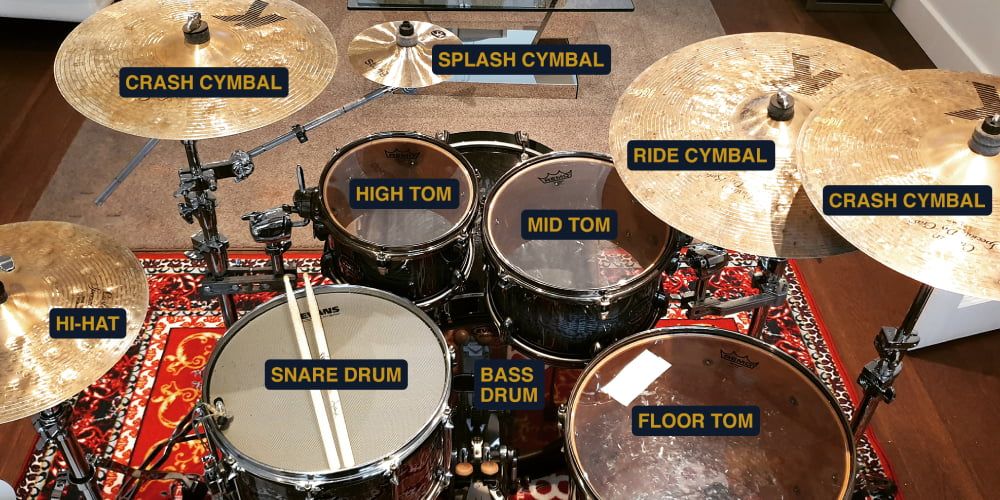
Not every drum set is the same. In fact, there are practically endless ways you could choose to set up your own drum set. It’s a highly customizable musical instrument, and that’s part of what makes it so fun!
The most popular type of drum set is a 5-piece drum set. It is called a 5-piece kit because it refers to the number of drums included in the set. With five drums, it offers a good balance of sonic diversity, compactness, and affordability.
Drum Set Parts in More Detail
Let’s take a look at all the different drum set parts that make up a 5 piece drum kit.
Snare Drum
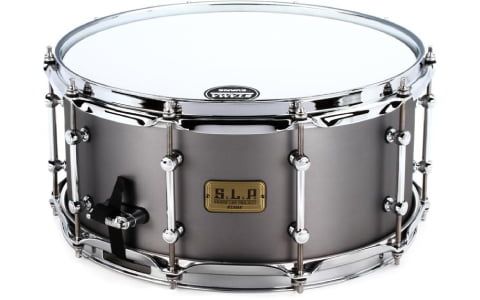
The snare drum is arguably the most important part of a drum set, and it’s the most played drum. It is positioned in between a drummer’s legs for convenient access to be played with both hands.
A snare drum produces the distinctive high-end pop sound that is archetypal within modern music. There are various parts of a snare drum that enable it to produce its distinctive snappy sound.
It has a set of snare wires on the underside of the drum that resonates when the batter snare drum head is struck. This is what creates the snare buzz sound.
A snare drum features a lever mechanism that allows a drummer to turn the snare wires on or off, and this is called a snare drum throw-off.
Snare drums are constructed with wood or metal, but they can also be made from acrylic. Wooden snare drums can be crafted with plies or solid wood (known as stave snare drums).
Snare drums are commonly sized at 14 inches in diameter but many drummers enjoy playing a 13-inch snare drum. Snare drums vary greatly in depth from anywhere around 3 inches to 8 inches, but most snare drums are around 5 or 6 inches deep.
A drummer’s snare is the most played component of his drum set and will help to define his musical voice behind the kit. Each particular model of snare drum has its own characteristics that project a unique musical tone.
Bass Drum

The bass drum can be described as the heart of the drum set. It’s the largest drum featured within a drum set and it’s operated with a bass drum pedal that is played by a drummer’s foot. Because of this, the bass drum is also commonly known as the kick drum.
The bass drum provides a distinctive low-end, punchy sound that helps to drive the beat. The Four on the floor is one of the most iconic patterns within modern music that’s played on the bass drum. In most common drum beats, the bass drum is played on the 1 and 3 counts.
Bass drums are commonly sized between 20 inches and 26 inches in diameter, with 22 inches being the most popular size for a kick drum.
Bass drums deliver a powerful, low-end tone that really helps to bring music to life, especially at live music concerts, where the punch can be felt right in your chest! To achieve this sound, a Bass drum microphone is placed through a porthole in the resonant drum head.
Additionally, a bass drum will benefit from some dampening to reduce the sustain of the note and minimize overtones; resulting in a more defined and punchy attack. A bass drum pillow is a great drumming accessory used to enhance the natural tone of a bass drum.
Rack Toms
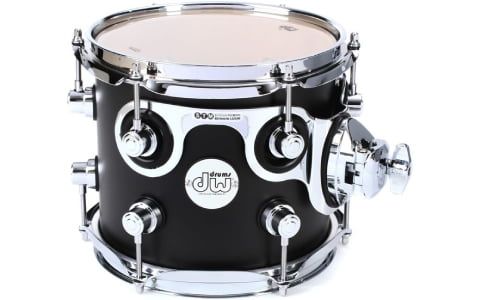
These drum parts are commonly known as the high tom and middle tom within a drum set. They produce an open, resonant tone with a defined pitch, and they are well-known for their use within iconic drum fills such as Phil Collins’ ‘In The Air Tonight’.
The sizes of toms vary – but the high tom is typically 10″ in diameter and the middle tom is 12″ in diameter. They are tuned and set up on a drum set to descend in pitch (smaller drums have a higher pitch), helping to create diverse sounds with drum grooves and fills.
Rack toms add a lot of sonic diversity and allow for plenty of experimentation while drumming. These parts of a drum set are important tools for musical expression!
Rack toms within beginner drum sets are typically mounted from a bass drum, with two tom arms supporting the rack toms. In intermediate and professional-level drum sets, rack toms are commonly mounted onto cymbal stands with a tom mounting arm.
Floor Tom
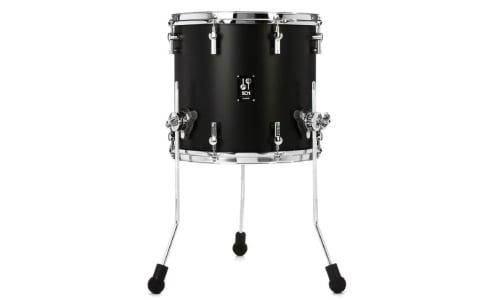
The floor tom is the largest-sized tom within a 5-piece drum set and the second-largest part of a drum kit after the bass drum. The floor tom produces a deep, powerful low-end boomy sound that’s more like a bass drum, and it’s commonly played within drum fills and grooves.
Floor toms are typically supported by floor tom legs, and this allows them to be positioned easily. But you might often see smaller 14-inch floor toms mounted onto a cymbal stand. 16-inch floor toms will generally always be supported by floor tom legs.
A floor tom is one of the most important parts of a drum set and is a staple component of rock, pop, and metal music. Lots of rock drummers often opt for having two or even three floor toms in a drum set!
Cymbals in a Drum Set

Cymbals are metal alloy discs that are the parts of a drum set used to produce a range of metallic sounds when struck. The vast majority of cymbals are bronze alloy, with the exception being very cheap beginner cymbals made from brass.
Cymbals come in all different sizes, with the smallest cymbals such as bell cymbals and splash cymbals being as small as 6 inches in diameter, while china cymbals and ride cymbals can be as large as 30 inches!
The weight and size of a cymbal directly impact its volume, pitch, and power. Smaller, thinner cymbals burst to life much quicker than larger and heavier cymbals. This is because the vibrations are able to travel faster through the metal.
A common 5-piece drum set will typically feature a pair of hi-hat cymbals, a crash cymbal, and a ride cymbal. This is the basic cymbal pack that will allow you to play most styles of music effectively.
Hi-Hat Cymbals
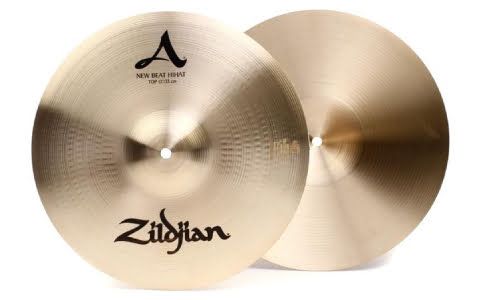
The hi-hat cymbals play a huge part in any drum set. Combined with the bass drum and snare drum, they are played in the vast majority of drum grooves you hear! They are particularly useful for keeping drummers in time as well as other musicians within a band.
Hi-hat cymbals come in a pair of two cymbals: with a bottom hi-hat and a top hi-hat. The bottom hi-hat is heavier than the top hi-hat cymbal. They are mounted onto a hi-hat stand, with the top hi-hat cymbal affixed onto the rod with a clutch.
Operating the hi-hat stand with your foot creates the classic percussive ‘chick’ sound as the two hi-hat cymbals close together. Most hi-hat cymbals are either 13 or 14 inches in diameter.
The hi-hats are able to produce a wide array of sounds, ranging from tight, quick, and crisp notes while played closed, all the way to a more sloshy, aggressive metallic roar while played open.
Crash Cymbal
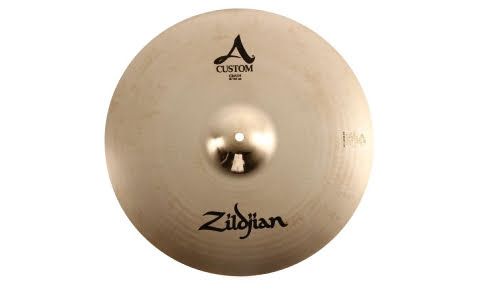
The crash cymbal is one of the most iconic parts of a drum set! The crash cymbal produces the distinctive explosive sound that is used to punctuate fills and accents in a song.
Crash cymbals are often played at the end of a drum fill, to help signify a musical transition. The sound of a crash cymbal is loud, washy, and explosive and cuts through the music with ease!
Crash cymbals can range from 14 inches in diameter to 22 inches, but most crash cymbals are sized between 16 and 20 inches. Crash cymbals also drastically vary in weight and thickness, altering the sound altogether.
Ride Cymbal
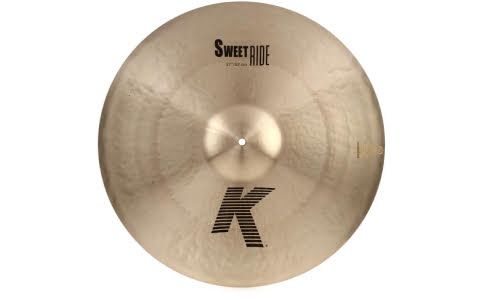
The ride cymbal is one of the largest parts of the drum set. They look fairly similar to crash cymbals, but they are larger; ranging from 20 inches upwards. They are typically heavier and feature a larger bell – adding more stick definition and a greater presence to the sound.
A ride cymbal is played differently from a crash cymbal. While a crash cymbal is struck hard on the edge of the cymbal, a ride cymbal is played softer either on the bell or the bow of the cymbal with the tip of the drumstick.
The ride cymbal produces a distinctive sound that is very common in jazz, blues, pop, and rock music. It is the clean and articulate ‘ping’ sound that has a defined note and a short sustain, in comparison to the long sustain and washy explosive sound of a crash cymbal.
Drum Hardware Supports the Different Parts of a Drum Set
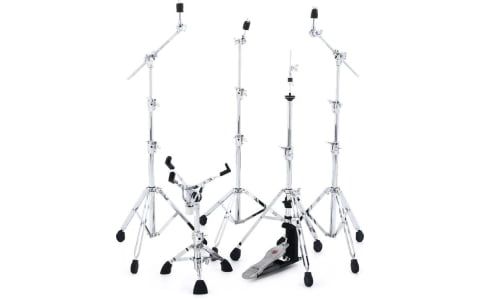
How do all the different parts of a drum set stay firmly in place? And how are they able to be positioned? The drum hardware is what supports the drums and cymbals in order to be played comfortably in a drum set.
Drum hardware is one of the less exciting parts of a drum set, but it is super important. The drum set wouldn’t exist without it! Most drummers use individual double-braced stands, but big drum sets will often utilize a drum rack to hold everything together.
It’s heavy and designed to be rock-solid in use with double-braced legs and large rubber feet for support. It is also designed with folding tripod bases to be stored easily and transported in a hardware case between shows and rehearsals.
Typically, beginner drum sets include all of the necessary drum hardware components used to mount a drum set. A 5-piece drum set requires the following drum hardware in order to be played.
- Bass drum pedal
- Hi-hat stand
- Snare drum stand
- Cymbal stand (for crash cymbal)
- Boom cymbal stand (for ride cymbal)
- Drum throne
Professional drum sets and intermediate-level drum sets do not include drum hardware as a part of the package. These are known as shell packs and these require you to purchase the drum hardware packs separately.
Can I Add More Drum Parts to My Drum Set?
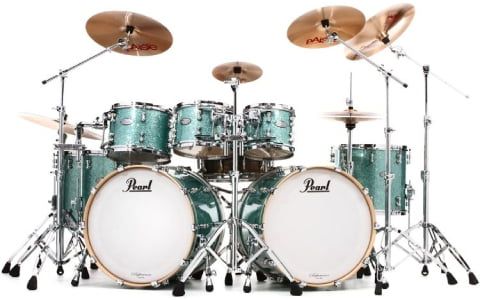
Of course! Every drummer is able to create a unique drum set to suit his or her own preferences. This is also what helps a drummer to develop his or her own unique playing style. By adding more drums and cymbals, a drummer is able to explore a wider range of sounds.
Drummers love to add new drum set parts to their existing drum set with a range of new and exciting components such as cymbals, drums, hardware, or drumming accessories.
By expanding your drum set with additional cymbals, more rack toms, another bass drum, or some cool drumming accessories; there’s a lot of fun to be had through investing in new gear and exploring new drum setups.
Summary
To summarize, here are the different parts of a drum set you can expect to find in a typical 5-piece drum kit.
- Snare drum
- Bass drum
- 2x Rack toms
- Floor tom
- Hi-hat cymbals
- Crash cymbal
- Ride cymbal
- Drum hardware
I hope you’ve enjoyed reading this article detailing the various parts that make up a drum kit, and that it has helped to provide you with some knowledge on the topic. Thanks for reading!








